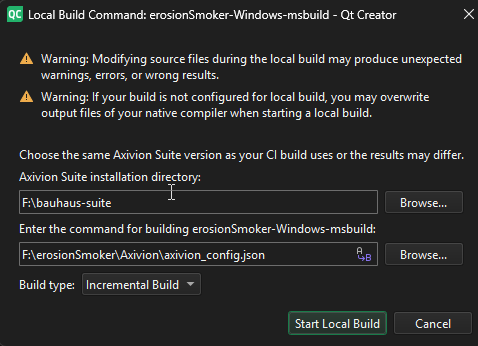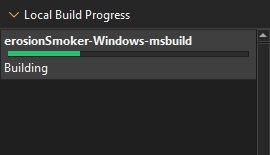使用 Axivion 进行本地分析
您可以在仪表板上对所连接的项目进行本地分析。在问题表中,选择相应的控制面板和项目。您需要在本地设置 Axivion Suite 并获得有效许可。
在 Axivion 视图内为活动项目设置本地构建:

- 在问题表中选择
 。
。 - 在Axivion Suite Installation Directory 中选择 Axivion Suite 基本目录。
- 输入命令或选择脚本或包含 Axivion 配置的相应 JSON 文件。
- 从Build Type 中选择构建类型。您可以选择 "纯净构建 "或 "增量构建"。
- 选择Start Local Build ,使用给定参数执行构建。
在Local Build Progress 中查看正在运行和已完成的本地构建。

右键单击本地构建可从上下文菜单中取消正在运行的构建。您可以在本地化完成后检查 Axivion 或本地化日志。选择Remove All Finished 可从本地构建进度中删除已完成的本地构建。
本地仪表板
如果当前选定的项目有本地构建,您可以切换到本地仪表板视图查看其结果。
选择 即可。这将启动本地仪表板并切换问题表以显示最新结果。
即可。这将启动本地仪表板并切换问题表以显示最新结果。
再次选择Local Dashboard 可切换回全局控制面板。
有关使用全局仪表盘的信息也适用于本地仪表盘(问题类型选择、筛选),但您只能选择有限的版本。
在Version 中,您可以在全局仪表板的参考版本和本地仪表板结果之间切换。根据本地构建结果,您可以将问题表限制为本地问题或已更改的问题。
另请参阅 "Axivion 偏好设置"、"查看 Axivion 静态代码分析结果"、"启用和禁用插件"、"如何:分析"、"分析器"和 "分析代码"。
Copyright © The Qt Company Ltd. and other contributors. Documentation contributions included herein are the copyrights of their respective owners. The documentation provided herein is licensed under the terms of the GNU Free Documentation License version 1.3 as published by the Free Software Foundation. Qt and respective logos are trademarks of The Qt Company Ltd in Finland and/or other countries worldwide. All other trademarks are property of their respective owners.

